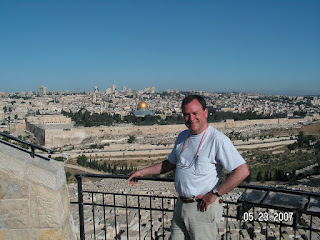
My Israeli tour was based around Christian holy sites, but I had many goals for the trip. I wanted to sample the people, politics, and history of the place as much as its religious sites. I got all that and more.
We went where Jesus went. That took us to Jerusalem first, then Bethlehem, Jericho, Capernaum, Nazareth, etc. Most of the shrines are in Arab-controlled or Israeli-controlled areas with majority Arab populations, so it was helpful to have a Palestinian Arab tour guide. He is a devout Christian, a seventy-four-year-old grandfather who had gone to seminary as a young man but dropped out. His knowledge of Old and New Testament Scripture and of the history of his country was vast and much superior to my own.
I’d had eleven years of Catholic education that included religion classes every day, but it wasn’t my favorite subject. After graduating high school, I became indifferent toward my religion for ten or twelve years and started going back to church only when I had children and they began asking questions about God. I know the basics of Old and New Testament scripture and I believe them, but I’ve never been inclined to evangelism. My faith is a private thing. I’ll discuss it with other believers but I don’t like to push it on anyone and I don’t often write about it.
On our second night in Jerusalem we were taken up on the roof of our Vatican-owned hotel by a resident priest named Father Kelly from Ireland’s County Clare. We could see nearly all of the Old City and much the new Jerusalem. It was dusk as Father Kelly pointed to the Mount of Olives from which Christ entered the city through the Golden Gate on Palm Sunday. Then he pointed to the Church of the Dormition, next to which the Last Supper was held on Thursday. From there, he explained, Jesus walked across the Kidron Valley back toward the Mount of Olives to the Garden of Gethsemane where He suffered His agony in anticipation of what was to happen the next day, Good Friday. Judas betrayed Him there and He was led back into the Old City as a prisoner. Father Kelly pointed out all the places where Jesus was passed around between Caiphas, Herod and Pilate - where He was condemned, crucified, died, was buried, and rose from the dead. This is the essence of Christianity and I had no idea it all happened in such a small area. I got an overview of my faith both literally and figuratively.
Very early the next morning our group’s priest, Father Bob Vaillancourt, took a few of us into the Old City to the Church of the Holy Sepulchre before the crowds arrived. In that ancient building are the sites of both the Crucifixion and the Resurrection. Two thousand years ago, they were just outside the city wall in the open. Now they’re in a huge building that’s been built and destroyed over and over since the 4th century. Though I’d been taught about the events of Holy Week many times during the past fifty years and had come to accept them, something changed. My awareness of what happened there was no longer just intellectual. It suffused me.
Jerusalem is the navel of the world, holy to three great religions, the followers of which comprise more than 40% of the world’s population. We Christians walked among Jews at the Wailing Wall and among Muslims just above it at the Dome of the Rock and the Al Aksa Mosque. History abounds with stories of conflict between and among all three religions. The war we fight today can’t be understood without knowledge of what the three have in common and what is different about them.
The political environment wasn’t too different in Christ’s day 2007 years ago from it is today. Jews ran the Temple Mount, of which only the Wailing Wall remains. Romans, with their pantheon of gods, ruled Israel. They destroyed the Temple in AD 70. Islam, the religion of Muslims, didn’t exist until Muhammad established it 600 years later. Muslims conquered Jerusalem in 632 and built the Dome of the Rock on the site of the former Jewish Temple. Christians led a Crusade to take Jerusalem from Muslims in 1099. Muslims retook it in 1187. Jews re-conquered Jerusalem in 1967. So it goes. At any given time during the past three millennia, conflicts were either just ending or just about to begin in Jerusalem. Periods of peace were short-lived. Jesus was in it but not of it. He transcended it.
A week before going to Israel, I watched a film called “John Paul II” with John Voight in the title role. As a young man, John Paul was an actor and college student in Poland when Nazis took over his country. He wanted to take up arms against them but was persuaded by a local priest that he could resist more effectively as a priest. Then the Soviet Union took over Poland and he resisted them too, ultimately smashing their rule with the help of Ronald Reagan and Margaret Thatcher. The Soviets sent an assassin who shot him twice in 1981, but he survived. Joseph Stalin once asked, famously: “How many divisions does the pope have?” A thousand years ago, popes had many. John Paul II, however, had none. As it turned out, he didn’t need any. Being the Vicar of Christ on earth was enough to defeat the Evil Empire.
John Paul II’s example was fresh in my mind when visiting Jerusalem and it helped me understand what Jesus did there there two thousand years ago.






